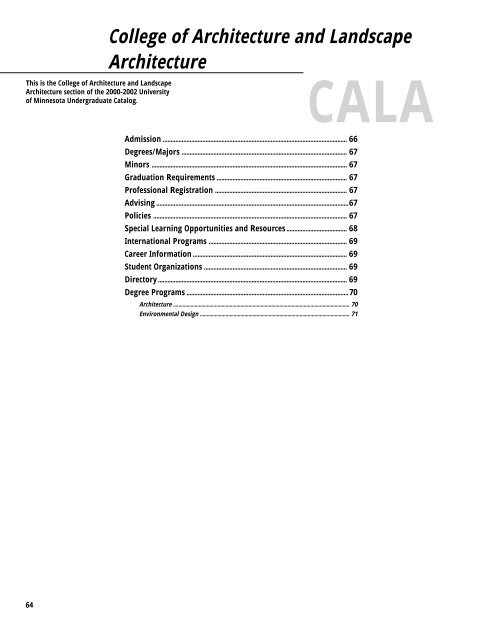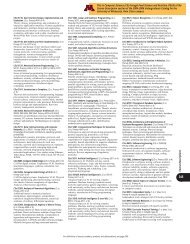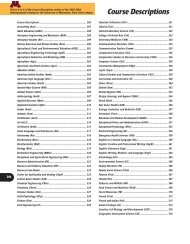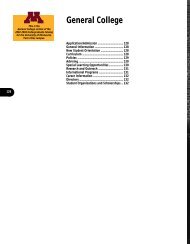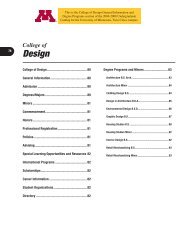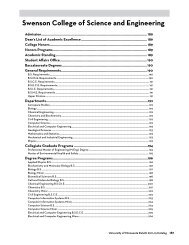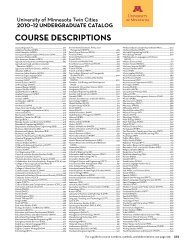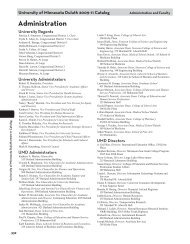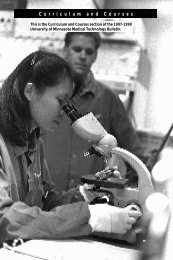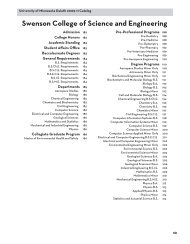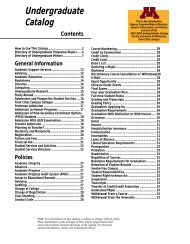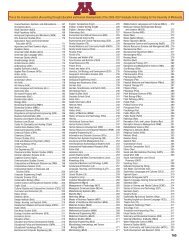College of Architecture and Landscape Architecture - University ...
College of Architecture and Landscape Architecture - University ...
College of Architecture and Landscape Architecture - University ...
You also want an ePaper? Increase the reach of your titles
YUMPU automatically turns print PDFs into web optimized ePapers that Google loves.
<strong>College</strong> <strong>of</strong> <strong>Architecture</strong> <strong>and</strong> L<strong>and</strong>scape <strong>Architecture</strong>This is the <strong>College</strong> <strong>of</strong> <strong>Architecture</strong> <strong>and</strong> L<strong>and</strong>scape<strong>Architecture</strong> section <strong>of</strong> the 2000-2002 <strong>University</strong><strong>of</strong> Minnesota Undergraduate Catalog.<strong>College</strong> <strong>of</strong> <strong>Architecture</strong> <strong>and</strong> L<strong>and</strong>scape<strong>Architecture</strong>CALAAdmission .................................................................................................................... 66Degrees/Majors ........................................................................................................ 67Minors ........................................................................................................................... 67Graduation Requirements .................................................................................. 67Pr<strong>of</strong>essional Registration ................................................................................... 67Advising .........................................................................................................................67Policies .......................................................................................................................... 67Special Learning Opportunities <strong>and</strong> Resources ...................................... 68International Programs ....................................................................................... 69Career Information ................................................................................................. 69Student Organizations .......................................................................................... 69Directory .......................................................................................................................69Degree Programs ......................................................................................................70<strong>Architecture</strong> ................................................................................................................................... 70Environmental Design ............................................................................................................... 7164
General Information<strong>College</strong> <strong>of</strong><strong>Architecture</strong> <strong>and</strong>L<strong>and</strong>scape <strong>Architecture</strong>65
<strong>College</strong> <strong>of</strong> <strong>Architecture</strong> <strong>and</strong> L<strong>and</strong>scape <strong>Architecture</strong><strong>College</strong> <strong>of</strong> <strong>Architecture</strong> <strong>and</strong>L<strong>and</strong>scape <strong>Architecture</strong>General Information66The <strong>College</strong> <strong>of</strong> <strong>Architecture</strong> <strong>and</strong> L<strong>and</strong>scape <strong>Architecture</strong>(CALA) is dedicated to advancing the quality <strong>and</strong> value<strong>of</strong> the designed environment. This pursuit addressesfundamental questions about the meaning <strong>and</strong> experience<strong>of</strong> people’s physical settings. L<strong>and</strong>scapes, cities, <strong>and</strong>buildings are the focus <strong>of</strong> study.Central to CALA’s mission is design education.Design is taught as the fundamental means by whicharchitects, l<strong>and</strong>scape architects, <strong>and</strong> urban designers giveshape to <strong>and</strong> explore their ideas. An effective designeducation develops creative powers <strong>of</strong> generalization <strong>and</strong>abstraction through analysis <strong>and</strong> synthesis; a broadunderst<strong>and</strong>ing <strong>of</strong> the arts, humanities, <strong>and</strong> sciences; aknowledge <strong>of</strong> the principles <strong>of</strong> the discipline’sappropriate technology, history, theory, <strong>and</strong> pr<strong>of</strong>essionalpractice; the skills necessary for describing, exploring,evaluating, <strong>and</strong> developing design ideas; <strong>and</strong> theconviction that appropriate aesthetic <strong>and</strong> ethical valuesare a pr<strong>of</strong>essional responsibility.CALA’s mission is pursued within the guidelines <strong>of</strong>the National Architectural Accrediting Board (NAAB),the Association <strong>of</strong> Collegiate Schools <strong>of</strong> <strong>Architecture</strong>(ACSA), <strong>and</strong> the L<strong>and</strong>scape Architectural AccreditationBoard (LAAB).Facilities—In addition to classroom, studio, <strong>and</strong> <strong>of</strong>ficespace, the college has specialized facilities available forstudent use. To support design studio activities, theCALA woodshop <strong>and</strong> its staff provide the tools <strong>and</strong> skillsneeded to turn ideas into objects. The CALA imaging labprovides photographic studio facilities <strong>and</strong> equipment fordocumenting projects, computer workstations for filmscanning <strong>and</strong> digital video editing, <strong>and</strong> videos <strong>of</strong> lectures<strong>and</strong> presentations given by distinguished teachers <strong>and</strong>practitioners. The CALA visual resources collectioncomprises approximately 100,000 slides to supportstudent <strong>and</strong> faculty research <strong>and</strong> educational activities.The <strong>Architecture</strong> <strong>and</strong> L<strong>and</strong>scape <strong>Architecture</strong> Libraryprovides full library services <strong>and</strong> has a collection <strong>of</strong> morethan 34,675 volumes. The CALA computing center, openseven days a week, supports several operating systems<strong>and</strong> a variety <strong>of</strong> graphics s<strong>of</strong>tware, including AutoCAD<strong>and</strong> ESRI Geographic Information Systems (GIS)applications, flat bed <strong>and</strong> slide scanners, large-formatplotters, a variety <strong>of</strong> printers, <strong>and</strong> video capabilities.Addition <strong>and</strong> Renovation—CALA has begun a projectto renovate <strong>and</strong> add to its existing building. Whenfinished the project will provide the space necessary tounite all the activities <strong>of</strong> the college. The renovationcomponent will provide improved design studios,additional class/jury rooms, research facilities, faculty<strong>and</strong> administrative <strong>of</strong>fices, <strong>and</strong> student facilities.The addition calls for a new library, lecture space,<strong>and</strong> additional studio area. It will function as a livinglaboratory <strong>of</strong> architecture <strong>and</strong> l<strong>and</strong>scape architecture,showcasing <strong>and</strong> monitoring the diverse <strong>and</strong> extensivebuilding products industry <strong>of</strong> the state. Anticipated datefor completion is fall 2001.The Design Center for American Urban L<strong>and</strong>scape(DC/AUL)—DC/AUL is a research unit within CALA.DC/AUL develops interactive educational projects inneighborhoods <strong>and</strong> communities, projects that addressnational urban design <strong>and</strong> planning issues. Students,pr<strong>of</strong>essionals, <strong>and</strong> community leaders collaborate <strong>and</strong>learn about making urban l<strong>and</strong>scapes through workingtogether on these projects. The Design Center’s missionis to educate public <strong>and</strong> private decision makers,pr<strong>of</strong>essionals, <strong>and</strong> citizens about the value <strong>of</strong> design as astrategic partner with economic <strong>and</strong> human interests inthe making <strong>of</strong> community-based development strategies<strong>and</strong> sustainable urban l<strong>and</strong>scapes.The Design Institute—This interdisciplinary unit withinCALA encompasses several <strong>University</strong> colleges withdesign-related programs, including CALA; the <strong>College</strong>s<strong>of</strong> Education <strong>and</strong> Human Development, Human Ecology,<strong>and</strong> Liberal Arts; Hubert H. Humphrey Institute <strong>of</strong> PublicAffairs; <strong>and</strong> Institute <strong>of</strong> Technology. The institute seeksto position the <strong>University</strong> as a world leader ininterdisciplinary design scholarship, education, <strong>and</strong>university-community partnerships. For informationabout a design minor, see “Degree Programs” in the<strong>College</strong> <strong>of</strong> Human Ecology section <strong>of</strong> this catalog.AdmissionFreshman Admission—Students in their senior year <strong>of</strong>high school, or those who have a high school degree orrecognized equivalent but have not studied at the collegeor university level, should apply through the Office <strong>of</strong>Admissions, 240 Williamson Hall, 231 Pillsbury DriveS.E., Minneapolis, MN 55455.Admission to the Major—For the B.S.Arch. program,students enrolled at the <strong>University</strong> may transfer to CALAfor the fall semester <strong>of</strong> their sophomore year at theearliest, by filing an Application for Change <strong>of</strong> <strong>College</strong> orStatus <strong>and</strong> declaring a pre-architecture major. Studentstransferring into the <strong>University</strong> with 30 semester creditsmay declare a pre-architecture major immediately uponadmission.B.A. students are admitted to the major inarchitecture after completing required pre-architecturecourses <strong>and</strong> 55-60 credits, including current enrollment.Students transferring from other institutions must beadmitted to the <strong>University</strong> before being admitted to theupper division major.Students enrolled at the <strong>University</strong> may declare anenvironmental design major at any point by filing anApplication for Change <strong>of</strong> <strong>College</strong> or Status. Studentstransferring into the <strong>University</strong> may declare anenvironmental design major immediately uponadmission.High School Preparation Requirements—If studentshave not satisfied high school preparation requirements,they will not be admitted to the architecture major orB.E.D. in l<strong>and</strong>scape architecture program <strong>and</strong> thereforewill not be allowed to take upper division programcourses. See “Freshman Admission” in the GeneralInformation section <strong>of</strong> this catalog.
General InformationDegrees/MajorsUndergraduate—CALA <strong>of</strong>fers a nonpr<strong>of</strong>essionalbachelor <strong>of</strong> environmental design (B.E.D.) degree; anonpr<strong>of</strong>essional bachelor <strong>of</strong> science in architecture(B.S.Arch.) degree; <strong>and</strong>, in cooperation with the <strong>College</strong><strong>of</strong> Liberal Arts (CLA), a nonpr<strong>of</strong>essional bachelor <strong>of</strong> arts(B.A.) degree with a major in architecture. The B.S.Arch.program includes an accelerated status option to allowqualified undergraduates to complete the undergraduate<strong>and</strong> M.Arch. degrees in six years rather than seven.Qualified undergraduates may also complete thenonpr<strong>of</strong>essional B.E.D. <strong>and</strong> the fully accredited M.L.A.degrees in six years rather than seven.Graduate—In conjunction with the Graduate School,CALA <strong>of</strong>fers both pr<strong>of</strong>essional <strong>and</strong> postpr<strong>of</strong>essionalgraduate degree programs in architecture <strong>and</strong> l<strong>and</strong>scapearchitecture. Descriptions <strong>of</strong> these programs are providedin the Graduate School Catalog.MinorsThe B.S.Arch. <strong>and</strong> B.E.D. programs incorporate a minoror elective concentration (a minimum <strong>of</strong> 15-21 approved3xxx-5xxx credits), allowing the student to develop atheme <strong>of</strong> study <strong>and</strong> broaden the social, cultural, <strong>and</strong>international aspects <strong>of</strong> design. Courses for a minor aretaken from a single department; courses for an electiveconcentration can be taken from a number <strong>of</strong> differentdepartments. Students may declare a minor in any<strong>University</strong> department or program <strong>of</strong>fering such anoption. At graduation the minor is listed on students’transcripts with their degree <strong>and</strong> major (an electiveconcentration is not listed). CALA <strong>of</strong>fers minors inarchitecture <strong>and</strong> environmental design in l<strong>and</strong>scapearchitecture.Graduation RequirementsStudents are recommended for graduation after theycomplete the prescribed curriculum, including required<strong>and</strong> elective courses to meet the total number <strong>of</strong> creditsrequired; earn a minimum cumulative GPA <strong>of</strong> 2.00overall <strong>and</strong> in their major; <strong>and</strong> complete the necessarypaperwork <strong>and</strong> meet the application deadlines.Two semesters before the expected graduation date,students should have an approved graduation check sheeton file with their department <strong>and</strong> the college <strong>of</strong>fice. Inaddition, students must turn in their graduationapplication to the Office <strong>of</strong> the Registrar. (Deadlineextensions are not granted.)Note: The <strong>College</strong> <strong>of</strong> Liberal Arts (CLA) grants aB.A. with a major in architecture. Students should checkthe CLA section <strong>of</strong> this catalog for information on CLAgraduation.Pr<strong>of</strong>essional RegistrationCALA provides Minnesota’s only accredited pr<strong>of</strong>essionaldegree programs in architecture (the M.Arch.) <strong>and</strong>l<strong>and</strong>scape architecture (the M.L.A.).As <strong>of</strong> 1990, all c<strong>and</strong>idates for pr<strong>of</strong>essionalregistration must graduate from a nationally accreditedpr<strong>of</strong>essional degree program (or its foreign equivalent)<strong>and</strong> complete three years <strong>of</strong> pr<strong>of</strong>essional work experienceto be eligible to take the state registration examination.Registration as an architect or l<strong>and</strong>scape architect is alegal requirement to practice in Minnesota <strong>and</strong> moststates in the country. Further, a pr<strong>of</strong>essional license isrequired before an individual may use the designation <strong>of</strong>architect or l<strong>and</strong>scape architect in any capacity.For more information concerning pr<strong>of</strong>essionalregistration, contact the Minnesota Board <strong>of</strong> <strong>Architecture</strong>,Engineering, L<strong>and</strong> Surveying <strong>and</strong> L<strong>and</strong>scape<strong>Architecture</strong>, <strong>and</strong> Interior Design (651-296-2388).AdvisingCALA Student Services Office—Prospective studentadvising provides general information about CALA’sdegree programs, related pr<strong>of</strong>essional fields inarchitecture <strong>and</strong> l<strong>and</strong>scape architecture, admission <strong>and</strong>program requirements, <strong>and</strong> college services, <strong>and</strong> refersprospective graduate students to the appropriatedepartment director <strong>of</strong> graduate studies.Department Advisers—Departments use a combination<strong>of</strong> faculty <strong>and</strong> staff advisers. Typically undergraduatemajors are advised by the department’s director <strong>of</strong>undergraduate studies, but may be advised by a CALAStudent Services adviser.PoliciesCourse Load—The average course load per semester forCALA undergraduates is five courses (13-16 credits) tograduate in four years without taking summer sessioncourses. One credit requires an average <strong>of</strong> three hours <strong>of</strong>work each week. Carrying more than 21 credits requiresspecial permission from the college scholastic committee.Repeating Courses—See “Grading <strong>and</strong> TranscriptPolicy” in the Policies section <strong>of</strong> this catalog.<strong>College</strong> <strong>of</strong><strong>Architecture</strong> <strong>and</strong>L<strong>and</strong>scape <strong>Architecture</strong>67
General InformationInternational ProgramsStudents are encouraged to incorporate a study abroadexperience into their degree program. Each year CALAhas arranged study trips for architecture <strong>and</strong> l<strong>and</strong>scapearchitecture pr<strong>of</strong>essional degree students to a variety <strong>of</strong>locations. In recent years these have included Europe,China, Meso-America, the Middle East, <strong>and</strong> theAmerican Southwest. Additionally, the college has<strong>of</strong>fered an undergraduate study abroad program inMexico. An exhibition <strong>of</strong> student work from the studyabroad program is held at the beginning <strong>of</strong> fall semester.For more information, contact the InternationalStudy <strong>and</strong> Travel Center, 94 Blegen Hall (612-626-4782);the Global Campus, 230 Heller Hall (612-626-9000); orthe CALA Student Services Office (612-626-1000).Career InformationCALA departments have a long history <strong>of</strong> closeassociation with their respective pr<strong>of</strong>essionalcommunities. Design pr<strong>of</strong>essionals teach in the studios asadjunct faculty, <strong>and</strong> students are strongly encouraged togain pr<strong>of</strong>essional work experience before graduatingfrom their pr<strong>of</strong>essional degree program. A portion <strong>of</strong> thestudent’s work experience may be applied to the threeyearpractice requirement for the pr<strong>of</strong>essional registrationexamination.Student OrganizationsMembership <strong>and</strong> participation in student organizationsadd a valuable dimension to a student’s academic career<strong>and</strong> contribute to pr<strong>of</strong>essional development.American Institute <strong>of</strong> <strong>Architecture</strong> Students (AIAS)—This independent, student-run organization informsstudents <strong>of</strong> current issues in architecture <strong>and</strong> promotesexcellence in architectural education. AIAS is involved invarious activities on local <strong>and</strong> national levels, includingcompetitions, design charrettes, social activities, portfolioworkshops, <strong>and</strong> college committee membership. Inaddition, AIAS works in conjunction with the AmericanInstitute <strong>of</strong> Architects <strong>and</strong> local firms to give students atangible connection to the pr<strong>of</strong>ession. AIAS studentsoperate a cooperative that sells art <strong>and</strong> design supplies tostudents at a significant discount.Minnesota Chapter <strong>of</strong> the American Society <strong>of</strong>L<strong>and</strong>scape <strong>Architecture</strong> Students (MASLAS)—Thisgroup, affiliated with the American Society <strong>of</strong> L<strong>and</strong>scapeArchitects, informs students <strong>of</strong> current issues inl<strong>and</strong>scape architecture <strong>and</strong> provides an excellentconnection to the pr<strong>of</strong>ession. The group is involved invarious activities, including the lecture series,competitions, design charrettes, social activities, <strong>and</strong>portfolio workshops.CALA Student Board—The student board consists <strong>of</strong>12 advanced undergraduate <strong>and</strong> graduate students. Theboard works toward the continued growth <strong>of</strong> a goodworking academic environment for students <strong>and</strong> faculty.CALA Mentor Program—The mentor program has itsroots as a student-founded <strong>and</strong> student-run organization.The mission <strong>of</strong> the program is to foster meaningfulrelationships between students <strong>and</strong> pr<strong>of</strong>essionals <strong>of</strong>architecture, l<strong>and</strong>scape architecture, <strong>and</strong> related fields.Directory(area code 612)Administrative OfficesOffice <strong>of</strong> the Dean149 Nicholson Hall, Minneapolis (academic year 2000-01)West wing <strong>of</strong> CALA addition, Minneapolis (after fall 2001)626-9068Student Services250/251 Nicholson Hall, Minneapolis (academic year 2000-01)West wing <strong>of</strong> <strong>Architecture</strong> Building, Minneapolis (after fall 2001)626-1000Departments <strong>and</strong> ProgramsDepartment <strong>of</strong> <strong>Architecture</strong>254 Nicholson Hall, Minneapolis (academic year 2000-01)West wing <strong>of</strong> <strong>Architecture</strong> Building, Minneapolis (after fall 2001)624-7866Department <strong>of</strong> L<strong>and</strong>scape <strong>Architecture</strong>1425 <strong>University</strong> Avenue S.E., Minneapolis (academic year 2000-01)West wing <strong>of</strong> <strong>Architecture</strong> Building, Minneapolis (after fall 2001)625-6860Design Center for American Urban L<strong>and</strong>scapeSuite 222, 1313 Fifth Street S.E., Minneapolis (academic year2000-01)Lower level <strong>of</strong> CALA addition, Minneapolis (after fall 2001)627-1850Design Institute100 Nicholson Hall, Minneapolis (academic year 2000-01)East wing <strong>of</strong> CALA addition (after fall 2001)625-3373L<strong>and</strong>scape Studies Center1425 <strong>University</strong> Avenue S.E., Minneapolis625-6860CALA Web Site<strong>College</strong> <strong>of</strong><strong>Architecture</strong> <strong>and</strong>L<strong>and</strong>scape <strong>Architecture</strong>Find itFind moreinformation aboutCALA on the Web at69
<strong>College</strong> <strong>of</strong> <strong>Architecture</strong> <strong>and</strong> L<strong>and</strong>scape <strong>Architecture</strong><strong>College</strong> <strong>of</strong> <strong>Architecture</strong> <strong>and</strong>L<strong>and</strong>scape <strong>Architecture</strong>Degree Programs70<strong>Architecture</strong>Department <strong>of</strong> <strong>Architecture</strong>B.S.Arch.<strong>Architecture</strong> encompasses the making <strong>and</strong> study <strong>of</strong> thebuildings <strong>and</strong> environment that we inhabit. The concerns<strong>of</strong> architecture involve a variety <strong>of</strong> areas <strong>of</strong> study,including the art <strong>of</strong> representing built projects throughdrawings <strong>and</strong> computer graphics; the technology <strong>of</strong>building structure, building materials, <strong>and</strong> natural <strong>and</strong>mechanical systems; the history, theory, <strong>and</strong> art <strong>of</strong>making, using, <strong>and</strong> underst<strong>and</strong>ing buildings as culturalartifacts for human use; <strong>and</strong> the practice <strong>of</strong> architecture inthe context <strong>of</strong> urban form <strong>and</strong> business economics.The bachelor <strong>of</strong> science in architecture (B.S.Arch.)degree provides instruction in history, representation,design, theory, <strong>and</strong> technology, emphasizing thedevelopment <strong>of</strong> architecture as a language <strong>of</strong> form, space,<strong>and</strong> order. The B.S.Arch. requires an underst<strong>and</strong>ing <strong>of</strong>social, cultural, <strong>and</strong> physical contexts as a foundation forthe examination <strong>of</strong> the methods, values, precedents, <strong>and</strong>material reality characteristic <strong>of</strong> the process <strong>of</strong> shapingnatural <strong>and</strong> built environments. The major combines coreprerequisites with a focused introduction to architecture,including required courses in representation, history,theory, <strong>and</strong> design processes <strong>and</strong> an individualizedelective concentration or minor planned by the studentwith the assistance <strong>of</strong> an adviser.The B.S.Arch. degree program deepens the study <strong>of</strong>architecture in the context <strong>of</strong> a liberal arts education,compared to the B.A. degree with a major in architectureprogram, which has a broader liberal arts base (see the<strong>College</strong> <strong>of</strong> Liberal Arts section <strong>of</strong> this catalog for moreinformation on the B.A. degree). The B.S.Arch. programmay be used as preparation for pr<strong>of</strong>essional study inarchitecture or related fields at the graduate level, or foremployment in architecture-related fields that do notrequire a pr<strong>of</strong>essional degree. The undergraduate majorestablishes a strong design foundation that serves avariety <strong>of</strong> careers <strong>and</strong> provides flexibility as individualopportunities change. A master’s degree in architecture isrequired to qualify for licensure.Admission Requirements—Students enrolled at the<strong>University</strong> may transfer to CALA in the fall semester <strong>of</strong>their sophomore year at the earliest. As pre-architecturemajors pursuing the B.S.Arch., students file anApplication for Change <strong>of</strong> <strong>College</strong> or Status <strong>and</strong>designate CALA as the college to which transfer isrequested. Students transferring into the <strong>University</strong> withat least 30 semester credits may enter CALA as prearchitecturemajors immediately upon admission.Students are admitted to the major based on spaceavailability <strong>and</strong> academic record.Application deadlines are November 1, March 1, <strong>and</strong>August 1. Students complete the following steps beforean application deadline.1. Complete all required architecture <strong>and</strong> generaleducation courses listed under Preparation for theMajor <strong>and</strong> liberal education requirements, totaling55-60 credits (may include current enrollment).2. Meet with the Department <strong>of</strong> <strong>Architecture</strong>undergraduate adviser in the CALA Office <strong>of</strong> StudentServices (612-626-1000). Bring a copy <strong>of</strong> thecompleted Pre-<strong>Architecture</strong> Planning Sheet <strong>and</strong> acurrent un<strong>of</strong>ficial transcript to the appointment.Students should be prepared to state the courses theywill take for their elective concentration or minor.Degree RequirementsStudents must complete at least 120 credits: 60 credits <strong>of</strong>pre-architecture study followed by 60 credits <strong>of</strong>coursework after admission to the major. At least 50credits must be in the major.During their B.S.Arch. program, students shouldmaintain a portfolio <strong>of</strong> originals or duplications <strong>of</strong> allfreeh<strong>and</strong> drawings, projects, <strong>and</strong> architecture studiodesigns. A portfolio is required for application to theaccelerated program <strong>and</strong> the graduate pr<strong>of</strong>essional degreeprogram.All architecture-designated courses (Arch) <strong>and</strong> therequired general education courses in math, physics, <strong>and</strong>English composition must be taken A-F with grades <strong>of</strong> C-or better to satisfy degree requirements <strong>and</strong> to progress tosequence courses.Required CoursesPreparation for the Major (31 cr)<strong>Architecture</strong> Courses (18 cr)RepresentationArch 1301—Introduction to Drawing in <strong>Architecture</strong> <strong>and</strong> L<strong>and</strong>scape<strong>Architecture</strong> (3 cr)History <strong>and</strong> Theory (15 cr)Arch 1401—The Designed Environment (3 cr)Arch 3401—Environmental Design <strong>and</strong> the Sociocultural Context (3 cr)Arch 3411—Architectural History to 1750 (3 cr)Arch 3412—Architectural History Since 1750 (3 cr)LA 3501—Environmental Design <strong>and</strong> Its Biological <strong>and</strong> PhysicalContext (3 cr)Required General Education Courses (13 cr)EngC 1011—<strong>University</strong> Writing <strong>and</strong> Critical Reading (4 cr)Math 1142—Short Calculus (4 cr)or Math 1271—Calculus I (4 cr)Phys 1101—Fundamental Physics I (4 cr)or Phys 1201—General Physics I (5 cr)<strong>Architecture</strong> Major Requirements (34 cr)RepresentationArch 3301—Drawing for Design in <strong>Architecture</strong> (3 cr)DesignArch 5281—Undergraduate <strong>Architecture</strong> Studio I (6 cr)Arch 5282—Undergraduate <strong>Architecture</strong> Studio II (6 cr)Additional upper division architecture courses (5xxx)This core requirement is being developed by faculty. See a Department<strong>of</strong> <strong>Architecture</strong> adviser for current information. (19–20 cr)Elective Concentration or Minor (15-cr minimum)B.S.Arch. c<strong>and</strong>idates develop an elective concentration orminor <strong>of</strong> 3xxx-5xxx courses outside the major as a means tobroaden the social, cultural, <strong>and</strong> international aspects <strong>of</strong> theirinterest area. Courses in the minor are generally selectedfrom one department (e.g., anthropology, art history,geography, political science). Courses for an electiveconcentration are chosen from various disciplines thatimpact design decisions (e.g., economics, geography,
<strong>College</strong> <strong>of</strong> <strong>Architecture</strong> <strong>and</strong> L<strong>and</strong>scape <strong>Architecture</strong>The architecture<strong>and</strong> l<strong>and</strong>scapearchitecture careerfairs give studentsthe opportunity tomeet practicingpr<strong>of</strong>essionals <strong>and</strong>discuss careertracks.72The three degree programs seek to integrate l<strong>and</strong>scapedesign with an ecological underst<strong>and</strong>ing <strong>of</strong> natural <strong>and</strong>cultural systems. National leadership in research, activetesting <strong>of</strong> design ideas at the local <strong>and</strong> national level, <strong>and</strong>the integration <strong>of</strong> these experiences into the classroom<strong>of</strong>fer a powerful springboard for design innovation.Collaborative opportunities within the college <strong>and</strong><strong>University</strong> allow students to explore <strong>and</strong> realize thepotentials <strong>of</strong> l<strong>and</strong>scape architecture <strong>and</strong> the need forecological responsibility in design <strong>and</strong> planning.Admission Requirements—Students enrolled at the<strong>University</strong> may declare an environmental design major atany point in their academic career. Students declare anenvironmental design major by filing an Application forChange <strong>of</strong> <strong>College</strong> or Status; students designate CALAas the college to which transfer is requested, with a majorin environmental design.Students transferring into the <strong>University</strong> may declare anenvironmental design major immediately uponadmission.Degree RequirementsStudents must complete at least 120 credits, including atleast 55 credits in the major.Students must complete all program, college, <strong>and</strong><strong>University</strong> requirements including the <strong>University</strong> <strong>of</strong>Minnesota, Twin Cities liberal education requirements.All LA-designated courses must be taken A-F, withgrades <strong>of</strong> C- or better. The B.E.D. in l<strong>and</strong>scapearchitecture provides a broad background in thebiological, physical, <strong>and</strong> social sciences <strong>and</strong> the liberalarts as they apply to design. Courses introduce studentsto the history, theory, <strong>and</strong> practice <strong>of</strong> l<strong>and</strong>scapearchitecture. Design experiences are supplemented bycourses in representation, technology, history, <strong>and</strong> theory.The B.E.D. program may be used as preparation forpr<strong>of</strong>essional study in l<strong>and</strong>scape architecture or relatedfields at the graduate level, or for employment in theenvironmental design <strong>and</strong> planning fields that does notrequire an accredited pr<strong>of</strong>essional degree.The department also <strong>of</strong>fers an accelerated status optionthrough the B.E.D. program. The accelerated statusoption admits a limited number <strong>of</strong> students annually <strong>and</strong>allows qualified undergraduates to complete the B.E.D.<strong>and</strong> M.L.A. in six years rather than seven years.Applicants for the accelerated status must complete thefirst three years <strong>of</strong> the B.E.D. degree requirements beforetheir senior year. Students must complete the first year <strong>of</strong>the pr<strong>of</strong>essional degree program in their undergraduatesenior year. These courses carry upper division credit <strong>and</strong>satisfy senior year B.E.D. requirements.Accelerated status is granted on a competitive basis <strong>and</strong>does not admit any student to the graduate pr<strong>of</strong>essionalprogram. Separate requirements, such as the GraduateRecord Examination (GRE) <strong>and</strong> other applicationdocuments, must be submitted in January <strong>of</strong> the year thatstudents are seeking admission to the graduate program.B.E.D. graduates who have completed the acceleratedstatus option <strong>and</strong> applied to the M.L.A. pr<strong>of</strong>essionaldegree program will receive advanced st<strong>and</strong>ing in theM.L.A. program upon acceptance by the Department <strong>of</strong>L<strong>and</strong>scape <strong>Architecture</strong> <strong>and</strong> the Graduate School.Required CoursesI. Foundation CoursesL<strong>and</strong>scape <strong>Architecture</strong>LA 1101—Introduction to Design Thinking (4 cr)LA 1301—Introduction to Drawing in <strong>Architecture</strong> <strong>and</strong> L<strong>and</strong>scape<strong>Architecture</strong> (3 cr)LA 1401—The Designed Environment (3 cr)General EducationRhet 1101—Writing to Inform, Convince, <strong>and</strong> Persuade (4 cr)Rhet 1223—Oral Presentations in Pr<strong>of</strong>essional Settings (3 cr)The following courses are recommended (not required) t<strong>of</strong>ulfill CLA’s liberal education requirement for at least 8credits <strong>of</strong> physical <strong>and</strong> biological sciences.Biol 1001—Introductory Biology I: Evolutionary <strong>and</strong> BiologicalPerspectives (4 cr)Biol 1009—General Biology (4 cr)Geo 1001—The Dynamic Earth: An Introduction to Geology (4 cr)Geo 1004—Physical <strong>and</strong> Historical Geology <strong>of</strong> Minnesota (4 cr)Geog 1403—Biogeography <strong>of</strong> the Global Garden (4 cr)Soil 1125—The Soil Resource (4 cr)The following courses are recommended (not required) t<strong>of</strong>ulfill CLA’s liberal education requirement for at least15 credits <strong>of</strong> social sciences <strong>and</strong> humanities.Geog 1301—Introduction to Human Geography (4 cr)Geog 3371—Introduction to Urban Geography (3 cr)Geog 3373—The Changing Form <strong>of</strong> the City (3 cr)Phil 3502—Introduction to Aesthetics (4 cr)II. Advanced CoursesL<strong>and</strong>scape <strong>Architecture</strong>Arch 3301—Drawing for Design in <strong>Architecture</strong> (3 cr)Arch 3401—Environmental Design <strong>and</strong> the Sociocultural Context (3 cr)EEB 3001—Ecology <strong>and</strong> Society (3 cr)FR 4131—Geographical Information Systems for Natural ResourceAnalysis (3 cr)LA 3001—Introduction to L<strong>and</strong>scape Architectural Design (3 cr)LA 3411—Architectural History to 1750 (3 cr)or LA 3412—Architectural History Since 1750 (3 cr)LA 3501—Environmental Design <strong>and</strong> its Biological <strong>and</strong> PhysicalContext (3 cr)LA 5204—L<strong>and</strong>scape Ecology (3 cr)LA 5413—Introduction to L<strong>and</strong>scape Architectural History (3 cr)LA 5571—L<strong>and</strong>scape Construction: L<strong>and</strong>form Systems <strong>and</strong> SpatialPerformance (4 cr)The following courses are recommended (not required) t<strong>of</strong>ulfill the two-course (6-8 cr) electives in l<strong>and</strong>scape planning<strong>and</strong> design.Arch 5452—<strong>Architecture</strong>: Design, Form, Order, <strong>and</strong> Meaning (3 cr)Arch 5711—Design Principles <strong>of</strong> the Urban L<strong>and</strong>scape (3 cr)Arch 5724—Meanings <strong>of</strong> Place (3 cr)FR 4501—Urban Forest Management (3 cr)Geog 3361—L<strong>and</strong> Use, L<strong>and</strong>scapes, <strong>and</strong> the Law (3 cr)Geog 5605—Geographical Perspectives on Planning (4 cr)Hort 4021—L<strong>and</strong>scape Design, Implementation, <strong>and</strong> Management I(4 cr)Hort 5021—L<strong>and</strong>scape Design, Implementation, <strong>and</strong> Management II(4 cr)NRES 3245—Recreation Policy <strong>and</strong> L<strong>and</strong>scape-Level Planning (3 cr)NRES 4395—Natural Resource Planning (3 cr)PA 4200—Introduction to Urban <strong>and</strong> Regional Planning (3 cr)PA 5001—Intellectual Foundations <strong>of</strong> Public Action (3 cr)General EducationRhet 3562—Technical <strong>and</strong> Pr<strong>of</strong>essional Writing (3 cr)The following courses are recommended (not required) t<strong>of</strong>ulfill the two-course requirement at the 4xxx-5xxx level(6-8 cr) in the physical <strong>and</strong> biological sciences.AgET 4223—Hydrology <strong>and</strong> Water Quality (3 cr)EEB 4002—Ecology <strong>of</strong> Minnesota (2 cr)EEB 4014—Ecology <strong>of</strong> Vegetation (3 cr)EEB 4016—Ecological Biogeography (3 cr)EEB 4601—Limnology (3 cr)EEB 4609—Ecosystem Ecology (3 cr)FR 4114—Forest Hydrology <strong>and</strong> Watershed Management (3 cr)FR 5104—Forest Ecology (4 cr)FR 5153—Forest <strong>and</strong> Wetl<strong>and</strong> Hydrology (3 cr)Geo 4701—Geomorphology (4 cr)Geo 4703—Glacial Geology (4 cr)Geog 5441—Quaternary L<strong>and</strong>scape Evolution (3 cr)
Hort 5071—Restoration <strong>and</strong> Reclamation Ecology (3 cr)NRES 5061—Water Quality: Management <strong>of</strong> a Natural Resource (3 cr)NRES 5575—Wetl<strong>and</strong>s Conservation (3 cr)PBio 4321—Taxonomy <strong>of</strong> Minnesota Flora (3 cr)III. Open ElectivesAt least 20 credits are required in open elective courses from anyprogram, at any level.Minor RequirementsStudents pursuing a minor must complete at least21 credits. Two courses are required; the remainder arechosen from a list <strong>of</strong> optional courses.Required Courses (6 cr)LA 1401—The Designed Environment (3 cr)LA 3413—Introduction to L<strong>and</strong>scape Architectural History (3 cr)Optional Courses (15 cr)Arch 3301—Drawing for Design in <strong>Architecture</strong> (3 cr)Arch 3401—Environmental Design <strong>and</strong> the Sociocultural Context (3 cr)Hort 1012—Woody L<strong>and</strong>scape Plants (3 cr)LA 1101—Introduction to Design Thinking (4 cr)LA 1301—Introduction to Drawing in <strong>Architecture</strong> <strong>and</strong> L<strong>and</strong>scape<strong>Architecture</strong> (3 cr)LA 3001—Introduction to L<strong>and</strong>scape Architectural Design (3 cr)LA 3501—Environmental Design <strong>and</strong> its Biological <strong>and</strong> PhysicalContext (3 cr)LA 5204—L<strong>and</strong>scape Ecology (3 cr)LA 5571—L<strong>and</strong>scape Construction: L<strong>and</strong>form Systems <strong>and</strong> SpatialPerformance (4 cr)LA 5573—L<strong>and</strong>scape Technology: Introduction to GeographicInformation Systems (3 cr)LA 8302—Pr<strong>of</strong>essional Practice (3 cr)Transfer Credits—A maximum <strong>of</strong> 9 transfer credits may be used for theminor.Overlapping Credits—A maximum <strong>of</strong> three courses taken for a majordegree may also be used toward the minor.A minimum grade <strong>of</strong> C- is required in all courses taken for the minor.Accelerated Status in Environmental DesignApplications for the accelerated status option in theB.E.D. program must be submitted by January 15 <strong>of</strong> theyear <strong>of</strong> desired entry. Admission is for fall only. Thefollowing policies <strong>and</strong> admission procedures changeperiodically; students should check with their adviser <strong>and</strong>the Department <strong>of</strong> L<strong>and</strong>scape <strong>Architecture</strong> for currentinformation.• Apply to the <strong>University</strong> <strong>of</strong> Minnesota if not already astudent.• Complete the first three years <strong>of</strong> the B.E.D.coursework.• Complete the accelerated status option applicationavailable from the Department <strong>of</strong> L<strong>and</strong>scape<strong>Architecture</strong> (612-625-6860).• Submit <strong>of</strong>ficial transcripts <strong>of</strong> all coursework at thecollege, university, or graduate level, includingcoursework currently being taken. Typically, a studentmust have a GPA <strong>of</strong> at least 3.00 for admittance.• Submit a letter <strong>of</strong> intent describing the student’sinterests, strengths, skills, <strong>and</strong> experiences related tol<strong>and</strong>scape architecture; l<strong>and</strong>scape architecture <strong>and</strong> theinterests, strengths, <strong>and</strong> skills needed to practice it asunderstood by the applicant; <strong>and</strong> why there is a goodfit between the applicant’s interests, strengths, skills,<strong>and</strong> experiences <strong>and</strong> l<strong>and</strong>scape architecture(maximum <strong>of</strong> two pages).• Submit a portfolio <strong>of</strong> art or design work,environmental or design reports, photographs <strong>of</strong> threedimensionalwork, slides, or similar examples <strong>of</strong>creative work. The work should convey the applicant’screative abilities <strong>and</strong> communication skills. It isstrongly suggested that the portfolio be a bound8 1/2 x 11-inch booklet. Portfolios larger than 24 x 36inches will not be accepted. Loose materials are alsounacceptable. Slides must be submitted in 8 1/2 x 11-inch transparent slide carrier pages.The l<strong>and</strong>scape architecture faculty votes on eachapplicant. The applicant may be admitted to theaccelerated status option or continued in the B.E.D.program. It is assumed that students who are acceptedwill complete their B.E.D. program in the acceleratedstatus option track <strong>and</strong> apply to the M.L.A. program.Admission is based on the• student’s academic st<strong>and</strong>ing <strong>and</strong> GPA• student’s underst<strong>and</strong>ing <strong>of</strong> l<strong>and</strong>scape architecture• fit between the student’s interests, strengths, skills,<strong>and</strong> experiences <strong>and</strong> l<strong>and</strong>scape architecture• student’s estimated potential to succeed as a practicingl<strong>and</strong>scape architect• staff <strong>and</strong> space availabilityApplicants are encouraged to visit the l<strong>and</strong>scape designstudios, talk to students who are in the accelerated optiontrack <strong>and</strong> the M.L.A. program, <strong>and</strong> find out as much asthey can about the pr<strong>of</strong>ession by talking with l<strong>and</strong>scapearchitects in their community.Applicants will be notified <strong>of</strong> the admission decision byMay 15. Successful applicants must notify thedepartment <strong>of</strong> their intention to enter by June 15 toreserve a position in the program.During their senior year, students in the acceleratedprogram enroll in the following courses:First Semester (14 cr)LA 5201—Making L<strong>and</strong>scape Spaces <strong>and</strong> Types (6 cr)LA 5133—Lake Itasca L<strong>and</strong>scape Analysis (1 cr)LA 5371—Computer Methods I (1 cr)PBio 4321—Taxonomy <strong>of</strong> Minnesota Flora (3 cr)Elective course (3 cr)Second Semester (14 cr)LA 5203—Ecological Dimensions <strong>of</strong> Space Making (6 cr)LA 5372—Computer Methods II (1 cr)LA 5571—L<strong>and</strong>scape Construction: L<strong>and</strong>form Systems <strong>and</strong> SpatialPerformance (4 cr)Elective (3 cr)Degree Programs<strong>College</strong> <strong>of</strong><strong>Architecture</strong> <strong>and</strong>L<strong>and</strong>scape <strong>Architecture</strong>Find itThe CALA StudentServices Office islocated in 250/251Nicholson Hallduring the 2000–2001 academic year.After fall 2001, the<strong>of</strong>fice will berelocated to thenewly renovated<strong>Architecture</strong>Building.73


